Adam Yamey's Blog: YAMEY, page 28
January 6, 2025
Chikkamma Tours (Pvt.) Ltd: a detective story set in Bangalore
THIS BOOK WAS RECOMMENDED to me by a bookseller in Bangalore, at Bookworm, because she said that the shop is mentioned in the book. In the novel, Chikkamma Tours is a small travel company located beneath a bookshop run by Jagat Desai. One night, he is murdered. His body is found the next morning by one of the ladies who work in the office beneath the bookshop. The police are informed, but the three women who work at Chikkamma Tours decide to make their own investigation of the murder. What they discovered about themselves and the crime are the subjects of this ‘whodunnit’ novel.
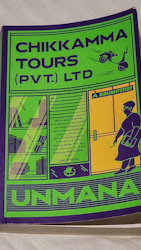
Although I enjoyed reading it, this book is not a great work of literature. However, it was fun and I liked it because it captures many aspects of life in a city I visit frequently: Bangalore. As I proceeded through it, I recognised many things I know about the city and, especially, its bookshops.
Would I recommend this book? I would to Bangaloreans and to people who know the city well. However, I am uncertain that it would appeal to those who have little or no connection with the city. That said, I am pleased that the lady at Bookworm suggested I should read it.
January 5, 2025
Hindoo Stuart and a son of a great author
THE SOUTH PARK Street Cemetery in Kolkata was opened in 1767 and was used as a burial ground for Europeans (mainly British) until 1830. It contains a large collection of funerary sculpture (mostly mausoleums and obelisks), much of which is in the neoclassical style. This now peaceful oasis in central Kolkata with much greenery is the final resting place of many people who had roles in the British East India Company (including its armies) and their families. Although the place contains the remains of many interesting people I will concentrate on two of them, both of whom had military careers.
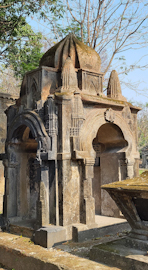 Tomb of Hindoo Stuart
Tomb of Hindoo Stuart Charles Stuart (c1758-1828) was born in Ireland (Dublin) and joined the East India Company when aged 19. He served in one of its armies, reaching the rank of Lieutenant Colonel. In India, he was attracted to, and fascinated by, Hindu culture and traditions. He adopted many Hindu ways of life including religious practices. For example, when off duty, he wore Indian clothes and bathed in the Ganges (the Hooghly) daily. In addition, he wrote many articles, published in the newspapers of Calcutta, which extolled the Indian ways of living, and encouraged Europeans to wear Indian garb rather than western clothing. He felt that ladies from Europe would feel more comfortable and look better wearing saris in India. His sympathy for the Indian modes of life and admiration of Indians earned him the nickname ‘Hindoo Stuart’, but did not impede his military career. His funerary monument in the South Park Street Cemetery is in the form of a small Hindu temple, quite different in form from all of the other monuments in the graveyard.
The other military person commemorated at South Park Street has a very modest, barely legible gravestone. It records the death of the short-lived Walter Landor Dickens (1841-1863). He was the fourth child and second son of the author of “Oliver Twist” and many other famous novels: Charles Dickens. Walter became an officer cadet in the East India Company armies, arriving in India in 1857, just before the so-called Indian Mutiny began. After the end of this revolutionary activity and the end of the Company’s rule in India and the start of the British government’s control of the country, he became a soldier in the British Army. Illness resulted in his death in a military hospital in Calcutta.
Walter was buried at the Bhowanipore Military Cemetery in Calcutta. In 1987, some students at Kolkata’s Jadavpur University raised funds and had Walter’s gravestone moved to the South Park Street Cemetery. This was done because it was not being cared for and to honour his father, the famous author.
Having recently become a fan of the novels of Charles Dickens, I was pleased to have been able to view Walter’s gravestone. The lettering on it is legible, but not too easy to read.
During our recent visit to the Cemetery, which we made in December 2024, we saw the two graves mentioned above and many others which we had not noticed on previous visits. For those interested in the early history of Kolkata during its British occupation, the South Park Street Cemetery should not be missed.
January 4, 2025
From Myanmar to the garden of Eden in Kolkata.
THERE IS A MAJOR cricket stadium in Kolkata called Eden Gardens. This world renowned sporting venue is adjacent to a far less well-known park: Eden Gardens Park. Established in about 1842, its fame was eclipsed by the opening of the cricket stadium in 1864. The stadium is named after the park.
Lord Auckland, the governor-general of India from 1836-1842, had ordered the construction of this pleasure ground. The garden was named after his sisters, Emily and Fanny Eden.
For a modest entry fee (20 rupees per person) one can enter the park, which contains a bandstand, flower beds, a rather rundown Japanese garden, a lake, a café, and a surprising feature that I will describe shortly. When we visited the park on a Saturday afternoon, there was a discotheque operating in the bandstand. The volume of music coming from the bandstand was excessive and unbearable. A local division of the Kolkata Police Special Department were having a party. Despite the racket, we strolled through the park to the attraction, which makes the park quite distinctive: a pagoda from Burma (Myanmar).
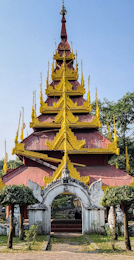
The wooden pagoda, which is in need of a little repairing, stands almost surrounded by the lake. The British brought it in pieces from Prome in Burma in 1854 at the end of the second Anglo-Burmese War (1852-1853), and reconstructed it in the park in 1856. Burmese workers put it together in the park.
Prome is known as ‘Pyay’ in Burmese. Regarding the period when the pagoda was removed to Calcutta, Wikipedia related:
“Called Prome by the British … the city became part of British territory after the Second Anglo-Burmese War in 1853. The town was taken by the British in 1825 during the Battle of Prome and again in 1852, on both occasions with hardly any opposition”. In 1862, the city was almost completely destroyed by fire. So, in a way, it was lucky that the wooden pagoda was saved from this conflagration.
The pagoda is an example of Tazoungs (idol house) architecture. It is surrounded by Burmese stone carvings. The pagoda used to contain a Buddha effigy, but this is no longer to be seen.
Kolkata is full of surprises. The Burmese pagoda is just one of them. I am glad we put up with the background noise in the park because I would have been disappointed not to view this unusual souvenir from Burma.
January 3, 2025
Praying along a busy street in Kolkata
SEI VUI IS OUR favourite Chinese restaurant in Kolkata. It is located on Black Burn Street that runs through what remains of the city’s old Chinatown. Black Burn Street runs off a busy main thoroughfare: Khirode Vidya Binode Avenue. On Friday, the 27th of December 2024, we walked to Sei Vui from Dalhousie Square at just after midday.
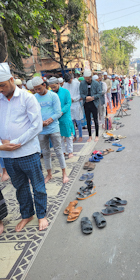
When we arrived at Khirode Vidya Binode Avenue, we saw something we had never observed before. There were many Muslim men in rows of four or five lining the north side of the road for many hundreds of yards. They were all facing the same direction. Some of these rows had many more men and extended into side streets including Black Burn Lane. Each man was barefooted and had his own prayer mat. This long line of men were performing Friday prayers. Every now and then they prostrated themselves on their mats, and then stood up again.
Our host and friend at Sei Vui explained that the local mosque is too small to accommodate the large number of Muslim men in the area. So, they pray in the street, facing the mosque. He said that he thought that what we had seen was a phenomenon unique to Kolkata. He believed that most other Muslims would not consider worshipping out on a busy street. On special occasions, there are so many worshippers that Khirode Vidya Binode Avenue has to be closed to vehicular traffic during the prayers.
It so happens that Khirode Vidya Binode Avenue runs in a mainly east/west direction. Also, the east end of the avenue is very slightly south of its west end. This being the case, by facing westward, as the worshippers were doing, one is looking approximately towards Mecca, which is west of Kolkata and slightly north of it.
We had an excellent lunch at Sei Vui. After we had finished, the prayers were over, the worshippers had left, and the avenue was back to normal.
January 2, 2025
Blackening the British perceptions of India and Indians
THE FIRST TIME I heard mention of Calcutta was when I was less than 11 years old. It was in connection with the so-called ‘Black Hole of Calcutta’. Without knowing anything about it, I got the impression that whatever happened there was extremely unpleasant. Today, the 27th of December 2024, we revisited the monument to the victims of the Black Hole incident, which now stands in the churchyard of Calcutta’s St John church. Formerly, it had stood in Dalhousie Square, where the Black Hole (a small prison cell) was located before it was demolished. Originally, there was a memorial on the spot, but this disappeared. The viceroy Lord Curzon had a new one made, and this is the one now standing near St John’s.
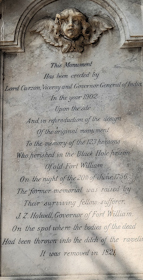 Part of the Black Hole memorial
Part of the Black Hole memorial When the British, unlike the French, refused to agree to the demands of the Nawab of Bengal, Siraj-ud-Daulah (1733-1757), the Nawab attacked Calcutta. Despite having some forewarning of the attack, the British did little to prepare their defences. On the 20th of June 1756, Calcutta’s Fort William fell to the Nawab.
The British survivors were rounded up by the Nawab’s forces and locked into the small prison now known as the Black Hole. The number of people incarcerated varies according to which account you read, but suffice it to say there were far too many people crowded into the tiny cell, and many of them died of overheating and thirst. It was a tragedy. Of that, there is no doubt.
The news of the Black Hole disaster led to an attack on the Nawab by the British led by Robert Clive (1725-1774). The Nawab was defeated at the Battle of Plassey in 1757.
The problem is that what happened in the Black Hole damaged British perceptions of Indians. As the historian John Zubrzycki wrote:
“The Black Hole would come to symbolise Indian barbarism in the minds of English policymakers and be used to strengthen the case for British rule.”
Worse than this, events such as the Black Hole and killing of British citizens during the so-called ‘Indian Mutiny’ of 1857, could be used to justify the many horrendous acts perpetrated by the Brits on Indians. Two notable examples of this are the cruel punishments meted out to the Indian soldiers who rebelled in 1757, and later the Jallianwala Bagh massacre of innocent Indian civilians in 1919.
That the monument to the victims of the Black Hole still stands in pristine condition so many years after India became independent is remarkable. In 1940, several leading independence activists, including Subhas Chandra Bose, campaigned to have the monument removed from Dalhousie Square. In July of that year it was moved to its present location. Today, we saw visitors, both Indian and Westerners, viewing the memorial.
January 1, 2025
Much more than 5000 years of the history of India in one short book
IT DID NOT TAKE LONG for me to read “The Shortest History of India” written by John Zubrzycki and published in 2023. I raced through the book not because it is short (264 pages) but because it is superbly written and highly engrossing.
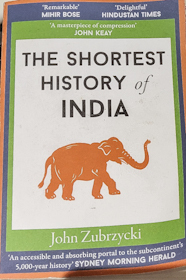
The author covers many of the key features of what is known about the complicated history of what is now India. He does not simply provide the reader with a simple list of facts, but also includes interesting comments about the events he mentioned. At times, he questions some conventionally accepted views and explanations of events and concepts.
The first half of the book covers the history of India from prehistoric times until the arrival of Europeans at the end of the sixteenth century. The period from then until the 2020s occupies the second half of the book. And much of the final 90 pages (34% of the text) deals with the period from 1857 until just afternoon the covid19 pandemic. So, I feel that if anything needs criticism it is that too much of the book is concerned with the last 4 centuries of India’s extremely long history. That said, the book is a first class, highly readable introduction to the amazingly complex story of the jigsaw puzzle of kingdoms, colonies, and empires that became India in 1947.
December 31, 2024
The power of faith and a polluted river
HAPPY NEW YEAR!
ON CHRISTMAS MORNING (2024), we walked leisurely beside the Hooghly River (a stretch of the Ganges) between Prinsep Ghat and Eden Gardens, a distance of about 1.3 miles. With a good paved footpath, this is a pleasant, picturesque, tree lined place to stroll.
Near Eden Park railway station, there is a popular bathing ghat (a flight of steps leading into the water). From a bridge that overlooks this, we watched people bathing in the river. Many of them immersed themselves fully several times. Others washed themselves. We saw people applying shampoo to wash their hair. I noticed a few men wading out into the water, carrying small trays containing flowers for puja. They threw these floral offerings into the fast flowing stream.
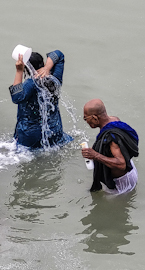
The Ganges, of which the Hooghly is a part, is considered to be a place of great holiness by Hindus. They believe that bathing in this river conveys several benefits including: cleansing the soul; connecting with divine cosmic forces; washing away bad karma from the present or previous births; health giving and healing; and removing negativity. So, if you are a believer, bathing in the Hooghly/Ganges must be a good thing. But, must it?
Signs along the path on which we strolled exhort people not to dump rubbish in the river. But it is clearly obvious that these signs are not obeyed. It is not only strollers’ rubbish that enters the sacred river. The river is being continuously polluted by sewage, industrial effluent, and decomposing corpses. This has resulted in high levels of toxic chemicals including heavy metals, and frighteningly large amounts of bacterial and other microbial pathogens.
According to several official bodies, the Hooghly has been deemed totally unsuitable for bathing. Yet despite this, there is no shortage of people entering the river to bathe, putting their entire heads underwater, and washing themselves with this water that carries a real risk of causing ill-health. Such is the power of faith that the well-publicized risks of bathing in the river are outweighed by the belief that the water can only benefit the bather.
December 30, 2024
Oh no, the baby is missing!
ON CHRISTMAS EVE (2024), we visited the Victorian gothic St Paul’s Cathedral in Kolkata (Calcutta). There was a creche (Nativity scene) in the garden. Unlike other such cribs we have spotted in the city, in which all the human characters look European, all of the (lifesize) models in the St Paul’s creche depict Indians. The three kings look like Rajput maharajas, a small boy near the crib is wearing kurta pyjamas, a shepherd carrying a lamb sports a turban, Joseph is wearing a dhoti, and Mary is dressed in a blue sari.
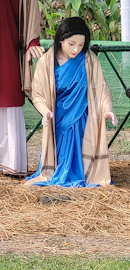
This beautifully made ensemble illustrating happenings in Bethlehem, where there was no room at the inn, is lacking one person. There was no baby Jesus to be seen. The model of Mary seems to be looking adorably at an empty patch of ground. I wondered whether someone had stolen the model of Jesus. We asked a gardener what had happened to baby Jesus. He replied: “It’s Christmas Eve. Jesus has not been born yet. He’ll come tonight.
December 29, 2024
Epic narration and a great plot: it would make exciting cinema
THE GORDON RIOTS which occurred in London in 1780 were a reaction to a law passed in 1778. The law gave rights to Roman Catholics and aroused the hostility of no-papists (anti-Catholics). The disturbances, which resulted in much destruction of property in London were instigated by the hateful propaganda of Lord George Gordon (1751-1793).
I first became interested in the Gordon Riots when I was writing my book about Hampstead and its surroundings. The rioters headed out of London towards Hampstead on their way to Lord Mansfield’s country house at Kenwood. Mansfield’s house in London’s Bloomsbury district had just been razed to the ground by the riotous mob, and they had hoped to do the same thing at Kenwood. Fortunately, they were stopped just before they reached Mansfield’s country mansion.
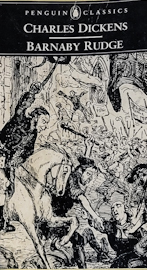
Given my interest in the above-mentioned, I was excited to find that Charles Dickens had written a novel about the riots: “Barnaby Rudge”. It was first published in 1841.
Barnaby Rudge is a peculiar character, a simpleton whose best friend is a talking raven. At first, it was not obvious to me why the novel should bear his name, but slowly his importance in this complex tale becomes evident. Although his role is important, there are a large number of other equally important characters woven into the plot.
Dickens explores the private antagonisms between some individuals as well as attractions between others, and gradually weaves these relationships into the ever increasing rumblings that develop into riots and mindless destruction.
Dickens wrote long before cinematography was invented, yet his written descriptions of both peaceful scenes and incredible chaos have a vividness and impact that much modern cinema (especially some blockbuster Bollywood productions) are able to throw at their audiences. And Dickens does this with words alone: without Dolby sound and dramatic photography.
In brief, I found “Barnaby Rudge” to be a veritable tour-de-force. My enjoyment of the book was enhanced by the fact that the Penguin edition I was reading was richly supplied with notes (mainly historical) researched and written by Gordon Spence.
Before reading “Barnaby Rudge”, I knew that the Gordon Riots were a fairly horrendous episode in British history. However, Dickens, who was writing just 40 years after they had occurred and might have known people who had witnessed them, brought this age of turmoil to life in a credibly dramatic way.
December 28, 2024
The Golders Green Complex in Calcutta (Kolkata)

DURING THE LONG taxi ride from Kolkata’s airport to the city centre, I noticed an intriguing sign on a building we passed. It read: “Golders Green Complex”. The reason that this interested me was that I was brought up in a northwest London’s suburb called Golders Green.
I have no idea if the proprietors of Kolkata’s Golders Green Complex know of the existence of my childhood haunt in northwest London. The idea that someone might suffer from a malady named the Golders Green complex flashed through my mind. How this would manifest itself, I will leave to your imagination. In my case, the lasting effect of a childhood in Golders Green led me to write a book about the place (https://www.amazon.co.uk/GOLDERS-GREEN-HAMPSTEAD-GARDEN-SUBURB/dp/B0BHG873FB/ )



